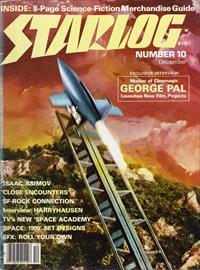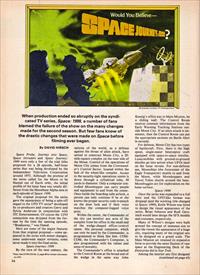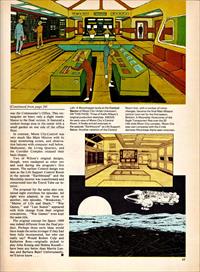Starlog
Starlog Articles
by David Hirsch
David Hirsch would cover these preproduction scenarios in more detail in To Everything That Might Have Been: The Lost Universes of Space: 1999 with Robert E Wood (2022)



Starlog 10 (December 1977)
When production ended so abruptly on the syndicated TV series, Space: 1999, a number of fans blamed the failure of the show on the many changes made for the second season. But few fans know of the drastic changes that were made on Space before filming ever began.
Space Probe, Journey into Space, Space Intruders and Space Journey: 1999 were only a few of the trial titles proposed for a 26 episode, half-hour series that was being developed by the Independent Television Corporation around 1973. Although the premise of the series called for the Moon to be blasted out of Earth orbit, the initial profile of the lunar base was totally different from the Moonbase Alpha seen in each episode of Space: 1999.
The original proposal for the series gave the appearance of being a spin-off sequel to the UFO TV series developed by co-producers and creators Gerry and Sylvia Anderson in conjunction with ITC Entertainment. Of course the UFO connection was dropped from the for- mat by the time the opening episode, "Breakaway," was filmed
Here are some of the major features from that original proposal--some appeared in the series with minor changes; some underwent major revision; some never made it into the final series.
By the turn of the next century, the nations of the world, as a defence against the threat of alien attack, have united to construct Moon City, a 20- mile-square complex on the near side of the Moon. Control of the operations of Moon City comes from the Commander's Control Sector, located within in hub of the wheel-like complex. Access to the security-tight operations centre is down through a cylindrical tube, 30 yards in diameter. Only a computer controlled Moonhopper can carry people and equipment to and from the centre. Once inside the boarding tube airlock, a person can only continue if he or she knows the proper security code to punch on the door lock and if their voice matches the computer-logged voice print
Within the centre, the Commander of the city can monitor any area of the complex from his office in the small end of the wedge-shaped office/control centre. His personal computer, which can only be used by the Commander, is programmed to think like him. COM- COM, the Commander's Computer, is also programmed with his values and sense of morality
The Commander's office is attached to the Control Room at the broad end of the wedge in the same way John
Koenig's office was to Main Mission, by a sliding wall. The Control Room receives constant information from the Early Warning Tracking Stations outside Moon City. If an alien attack is imminent, then the Control Room can put the appropriate sections on Battle Alert in seconds
For defence, Moon City has two types of battlecraft. First, there is the high speed, single-seater Interceptor craft equipped with space-to-space missiles. Lunarmobiles with ground-to-ground missiles go into action when UFOs land on the lunar terrain. For non-defence use, Moonships (the forerunner of the Eagle Transporter)shuttle to and from the Moon, while Moonhoppers and Travel Tubes shuttle around the base. Moonbuggies are for exploration on the lunar surface.
Once the series was expanded to a full hour and the UFO-like format was dropped (and the working title changed to Space: 1999 ), Keith Wilson was hired to design the visual appearance of the series. Brian Johnson and Rudi Gernreich would later design the SFX models and costumes, respectively
Many of Wilson's designs were built around the concept of immense size to give the viewer the appearance of a huge city, requiring many of the original sets to be designed on a grand scale. The Main Mission set retained its expansive form to provide the same illusion of vast space as the Engineering Deck of the Enterprise did in Star Trek.
Among the interior sets first designed was the Commander's Office. This rectangular set bears only a slight resemblance to the final version. It featured a sunken lounge area in the centre with a small garden on one side of the office floor
In contrast, Moon City Control was very much like Main Mission with its large monitoring screen, and observation balcony with computer wall below. Medicenter, the Living Quarters, and the Corridor Complex retained their basic shapes
Two of Wilson's original designs, though, were readapted as other sets and used during the program's first season. The earliest Control design was seen as the Life Support Control Room in the episode "Earthbound" and the Moonship interior was transformed and compressed into the Travel Tube car interior
The proposal for the series also contained eight storylines for episodes. All eight were adapted, in one form or another, into episodes, "Breakaway," "Matter of Life and Death," "War Games," and "Last Sunset" appeared with little change from their original conceptions, "War Games" even kept the same title
The original concept for Space: 1999 was indeed different from the final product. Perhaps those early ideas would have made the series stronger if they had been fully incorporated, but who can really say? Would Robert Culp and Katherine Ross--originally picked to play John Koenig and Helena Russell-- have been any better than Martin Landau and Barbara Bain? Unfortunately, we'll never know ...Gerry Anderson denied Katherine Ross was considered